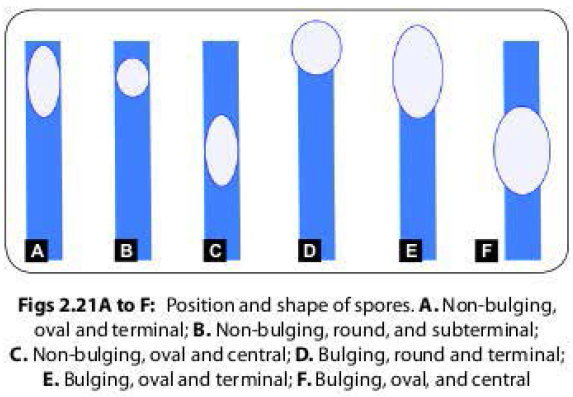Bacterial spores are highly resistant resting (or dormant) stage of the bacteria formed in unfavorable environmental conditions as a result of the depletion of exogenous nutrients.
Bacterial spores formed within the parent cell, are called endospores and the remaining part of the bacteria is called the sporangium.
Structure of Bacterial Spore:
Bacterial spore comprises of several layers. From innermost towards the outermost, the layers are: core--> cortex--> coat--> exosporium (Fig. 2.20A).
The core is the inner most part containing the DNA material and is walled off from the cortex by an inner membrane and the germ cell wall.
Cortex and the coat layers lie external to the core and are separated from each other by an outer membrane.
The outermost layer is called the exosporium.
Sporulation
Sporulation (or sporogenesis)
refers to the process of formation of spores from vegetative stage of bacteria.
It is not a method of reproduction because the bacteria do not divide during
sporulation.
Sporulation commences when
growth ceases due to lack of nutrients. It is a complex process, takes about 10
hours which may be divided into seven stages (Fig. 2.208).
1. Stage I (axial filament formation): Bacterial cell division occurs and an axial filament of nuclear material is formed.
2. Stage II (septum formation): Cell membrane is folded inwards to enclose part of the DNA and to produce the forespore septum.
3. Stage III (engulfment of forespore): The membrane continues to grow and engulfs the immature spore in a second membrane.
4. Stage IV: The cortex synthesis occurs in the space between the two membranes with deposition of calcium and dipicolinic acid.
5. Stage V: Formation of protein coat and exosporium around the cortex
6. Stage VI: Maturation of the spore occurs; acquiring properties of heat resistance and refractility.
7. Stage VII (release): Finally, lytic enzymes destroy the sporangium releasing the spore.
Germination of Bacterial Spore
It is the transformation of dormant spores into active vegetative cells when grown in a nutrient-rich medium. It comprises of three stages:
Activation: It is reversible process that prepares spores for germination and usually results from treatments like heating.
Germination: It is the process of breaking of the spore's dormant state, characterized by spore swelling, rupture or absorption of the spore coat, loss of resistance co heat and other stresses, loss of refractility, release of spore components, and increase in metabolic activity.
Outgrowth: The spore protoplast emerges from the remains of the spore coat, and develops into an active bacterium.
Shape and Position of Spores
For a given species, the
precise position, shape and relative size of the spore are constant.
Position: Spores may be central, subterminal or terminal (Fig. 2.21).
Shape: They may be oval or spherical in shape.
Width: The diameter of spore may be same or less than the with of bacteria (non-bulging spore- e.g. as in Bacillus), or may be wider than the bacillary body producing a distension or bulge in the cell (bulging spore, e.g. as in Clostridium).
Sporicidal
Agents
Spores are resistant to most of the routinely used disinfectants. Only limited sterilization methods are available to kill the spores:
1. Ethylene oxide
2. Peracetic acid
3. Formaldehyde
4. O-phthalic acid
5. Glutaraldehyde
6. Hydrogen peroxide
7. Autoclave
8. Hot air oven
9. Plasma sterilization
Demonstration of Bacterial Spores
Gram staining: Spores appear as unstained refractile bodies within the cells.
Modified Ziehl-Neelsen staining: Spores are weakly acid-fast and appear red in color when ZN staining is performed using 0.25% sulphuric acid as decolorizer.
Special techniques for endospore staining include the Schaeffer-Fulton stain and the Moeller stain.
Applications of Bacterial Spores
- Spores of certain bacteria are employed as indicators for proper sterilization. Absence of the spores after autoclaving or processing in hot air oven indicates proper sterilization.
- Spores of Geobacillus stearothermophilus are used as sterilization control for autoclave.
- Spores of nontoxigenic strains of Clostridium tetani are used as sterilization control for hot air oven.
- Spores have also been used as agents of bioterrorism, e.g. endospores of Bacilluss anthracis were used in the 2001 anthrax bioterrorism attacks.



Thanks...
ReplyDelete